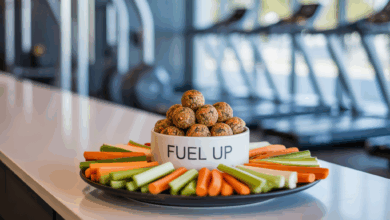Full Body Endurance Workout for Everyone — Build Stamina, Strength & Confidence

Have you ever been winded after climbing a flight of stairs or felt like your energy fades halfway through the day? What if a simple, balanced routine could boost your stamina, tone muscles, and fit into your busy life — no gym required? This full body endurance workout for everyone is designed to be practical, adaptable, and sustainable so you can build lasting aerobic and muscular endurance.
Why endurance training matters for everyday life
Endurance isn’t just for runners or athletes. Aerobic endurance and muscular stamina power daily activities — carrying groceries, playing with kids, or staying alert at work. A total-body endurance program improves heart health, increases metabolic efficiency, and helps reduce fatigue. It also supports weight management and mental resilience by improving sleep and reducing stress.
How to do a full body endurance workout for everyone
This balanced routine blends cardio, bodyweight strength, and mobility. It’s scalable — choose intensity and duration based on fitness level. Aim for 3 sessions per week, or add shorter sessions on active recovery days.
Warm-up (5–8 minutes)
- Joint circles (neck, shoulders, hips, knees) — 1 minute
- Marching or brisk walking in place — 2 minutes
- Dynamic lunges with torso twist — 1 minute
- Arm swings + leg swings — 1–2 minutes
Main circuit — 30–35 minutes
Perform 3–4 rounds of the following circuit. Work at a pace where you can talk but not sing (moderate to moderately hard). Rest 60–90 seconds between rounds.
- Bodyweight squats — 15–20 reps (builds lower-body muscular endurance)
- Incline push-ups or knee push-ups — 10–15 reps (upper-body endurance)
- Alternating reverse lunges — 12 reps per leg (balance + stamina)
- Plank to push-up (up-down plank) — 10 reps (core endurance)
- Mountain climbers — 30 seconds (cardio burst)
- Glute bridges — 15–20 reps (posterior chain endurance)
- Low-impact cardio: March or step touch — 60 seconds
Finish with a 5–7 minute cool-down of walking or gentle stretching to aid recovery.
Progressions and variations
- Beginner: Reduce rounds to 2–3, lower reps (8–12) and lengthen rest (90–120s). Focus on form.
- Intermediate: Follow prescription above and minimize rest to 45–60 seconds as stamina improves.
- Advanced: Add weighted exercises, increase to 4–5 rounds, or substitute jump squats, burpees, and high-knees for higher intensity HIIT-style endurance.
- Low-impact option: Replace jumping moves with step-ups or brisk marching to protect joints while improving aerobic capacity.
Practical fitness tips to get the most from this routine
- Consistency beats intensity: Aim for regular sessions (3–5 per week) rather than occasional intense workouts.
- Mix modalities: Add a 20–40 minute steady-state bike ride or brisk walk once a week to build aerobic base.
- Monitor effort, not just heart rate: Use Rate of Perceived Exertion (RPE) — target 5–7 out of 10 for endurance work.
- Track progress: Note rounds completed, reps, or how you feel after stairs or chores — measurable gains are motivating.
- Use proper recovery: Sleep 7–9 hours, hydrate, and include foam rolling or mobility work to reduce soreness.
Nutrition and lifestyle advice to support endurance gains
Your body needs fuel to perform and recover. Focus on whole foods, steady protein intake, and carbohydrates timed around workouts for energy.
- Pre-workout: Small snack with carbs + protein 30–60 minutes before training (banana with nut butter or yogurt with fruit).
- Post-workout: Protein + carbs within 1–2 hours to repair muscle (e.g., smoothie with protein powder and oats).
- Hydration: Drink water throughout the day; add electrolytes if you sweat heavily during longer sessions.
- Recovery nutrition: Include anti-inflammatory foods — berries, leafy greens, fatty fish — and prioritize fiber and micronutrients.
Real-world examples — how this fits into different lives
Case 1: Busy parent — Anna does two 25-minute circuits during nap time and a 20-minute walk in the evening. The short, consistent sessions build stamina for chasing kids and everyday chores.
Case 2: Office worker — Mark does the routine three mornings a week, plus a lunchtime brisk walk. He notices fewer midday energy slumps and better posture after weeks of squats and glute work.
Case 3: Older adult — Rita uses the low-impact variation with chair-supported squats and step-ups. Over time she’s improved balance and can enjoy longer family hikes.
Frequently Asked Questions
1. Is this full body endurance workout safe for beginners?
Yes. The routine is scalable. Start with fewer rounds, lower reps, and longer rest. Focus on technique and consult a healthcare provider if you have chronic conditions or recent injuries.
2. How often should I do this workout to see results?
Aim for at least three sessions per week combined with one or two low-intensity cardio days (walking, cycling). Most people notice improved stamina and energy within 4–6 weeks with consistent training and good recovery.
3. Can I build endurance without running?
Absolutely. Endurance can be developed with circuit training, cycling, swimming, rowing, or brisk walking. The key is steady cardiovascular stimulus plus muscular endurance work — all included in this full body endurance workout for everyone.
Additional recovery and long-term training tips
- Periodize your training: Alternate higher-volume weeks with lighter weeks to avoid plateaus and overtraining.
- Cross-train: Include flexibility and low-impact cardio sessions to reduce injury risk and reinforce aerobic capacity.
- Stay patient: Endurance gains accumulate gradually. Celebrate small wins like fewer gasps on stairs or longer play sessions with family.
Conclusion — Start your full body endurance journey today
If you want more energy, better mood, and the strength to handle everyday tasks, this full body endurance workout for everyone offers a simple, adaptable plan. Start with one circuit today, tweak the intensity to match your fitness level, and build from there. Want ready-made plans and meal tips to support your progress? Check out our workout routines, browse our nutrition guides, or explore practical wellness tips to stay consistent. Ready to feel stronger and more energetic? Get moving — you’ve got this.





